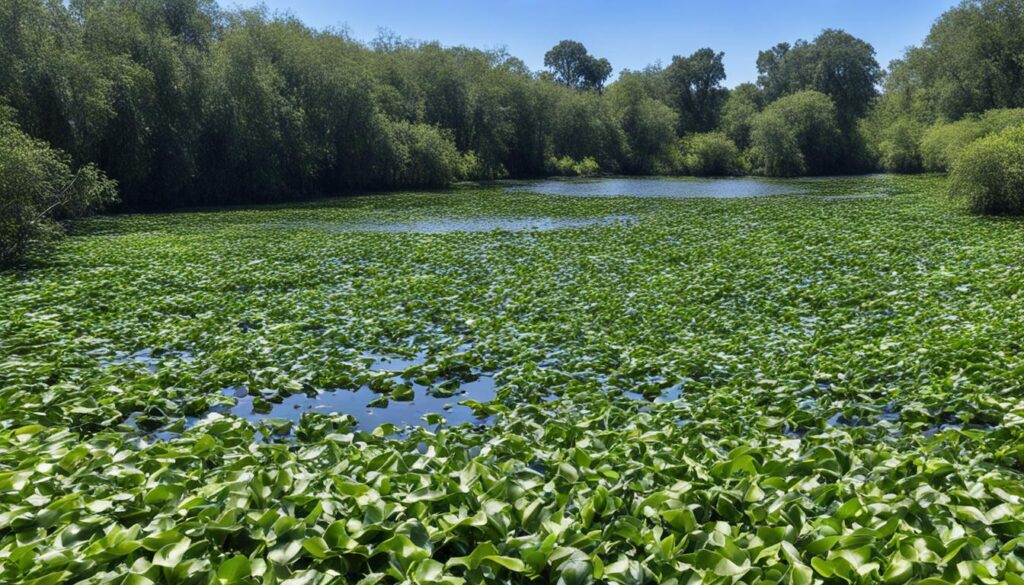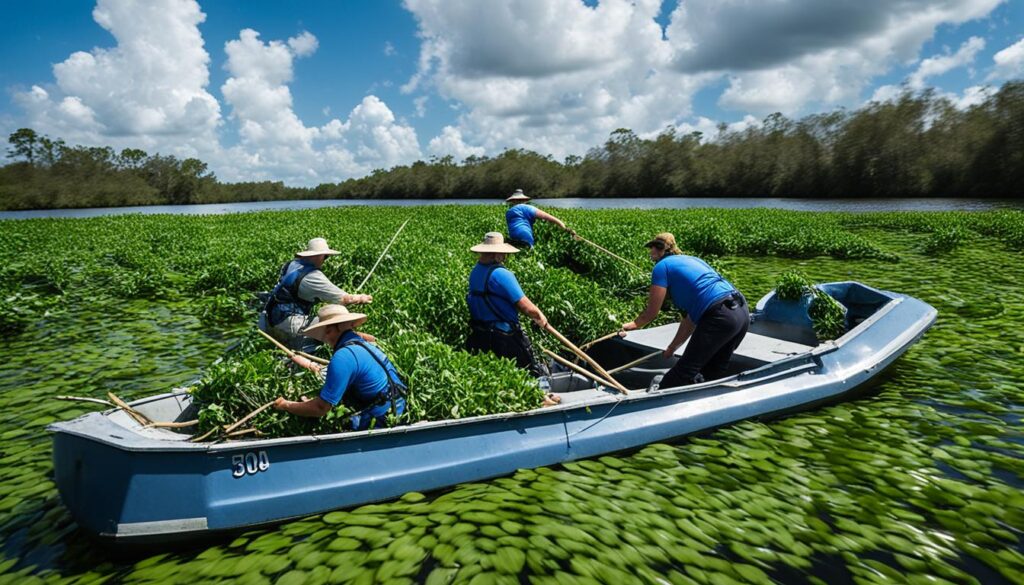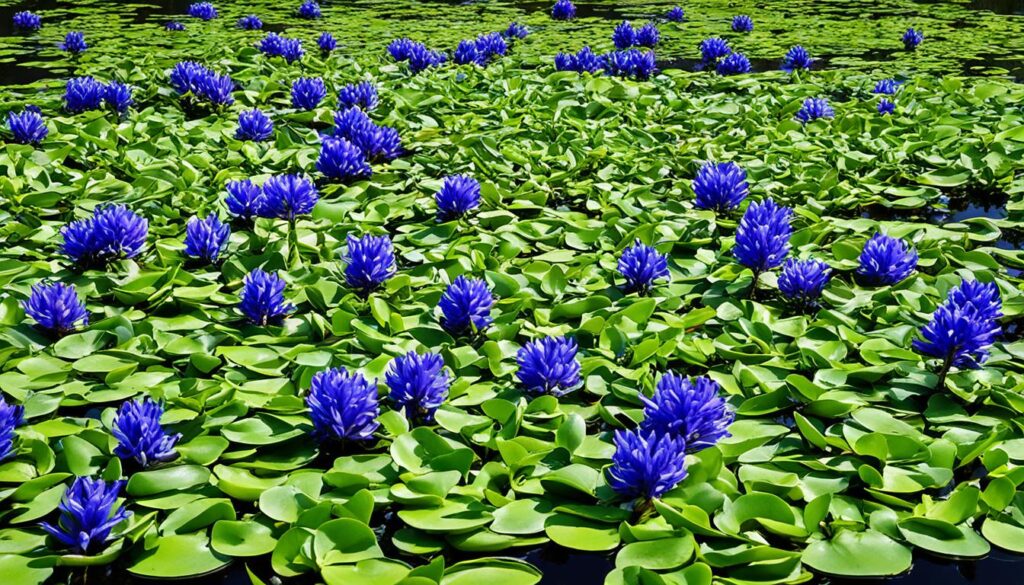Water hyacinth, an invasive aquatic plant, has become a significant issue in Florida’s waterways. With its rapid growth and ability to outcompete native species, water hyacinth threatens the delicate balance of Florida’s aquatic ecosystems. As an expert in environmental conservation, I have witnessed firsthand the detrimental impact of this invasive species on our state’s natural resources.
Water hyacinth, known scientifically as (Eichhornia crassipes), is originally from the Amazon basin in South America. It was introduced to Florida in the late 1800s as an ornamental plant, but its aggressive nature soon turned it into a menace. Today, it is considered one of the most invasive aquatic plants in the state, wreaking havoc on our aquatic ecosystems.
One of the main challenges water hyacinths face is their ability to reproduce rapidly. One plant can produce thousands of seeds, then dispersed by wind, water currents, and human activities. This rapid reproduction cycle allows water hyacinths to colonize large areas of water bodies, forming dense mats that block sunlight and hinder the growth of native flora.
In addition to blocking sunlight, water hyacinth causes oxygen depletion levels in the water; this invasive plant disrupts natural water flow, increases the risk of flooding, and hampers recreational activities such as boating and fishing. Furthermore, the plant’s decomposition reduces water quality, creating an environment where harmful algal blooms and other waterborne diseases can thrive.
Controlling water hyacinths in Florida requires a multi-pronged approach. This includes manual removal, chemical treatments, and introducing biological control agents such as weevils and grass carp. While each method has advantages and limitations, a combination of approaches is often necessary to manage the invasive plant effectively.
Angler’s Essentials:
- Water hyacinth is an invasive aquatic plant that threatens Florida’s waterways.
- It reproduces rapidly, forming dense mats that block sunlight and deplete oxygen levels in the water.
- Water hyacinth disrupts natural water flow, reduces water quality, and hampers recreational activities.
- Controlling water hyacinth requires a multi-pronged approach, including manual removal, chemical treatments, and biological control agents.
- Ongoing efforts are crucial to mitigate the impact of water hyacinths on Florida’s aquatic ecosystems.
Understanding Water Hyacinth’s Invasion in Florida
Water hyacinth has become a significant concern in Florida’s aquatic ecosystems. As an invasive species, it threatens native plants and wildlife, disrupts waterways, and impacts recreational activities. To effectively manage this issue, it is essential to understand the reasons behind the water hyacinth’s invasion in Florida and explore the various methods used for controlling and managing this invasive species.
The Challenge of Controlling Water Hyacinth in Florida
Water hyacinth, commonly known as Eichhornia crassipes, is native to South America but has spread to many parts of the world, including Florida. Its rapid growth and ability to reproduce quickly make it difficult to control. The favorable climate, abundant water sources, and absence of natural predators in Florida contribute to the aggressive spread of water hyacinth in the state’s water bodies.
Effective management of water hyacinths in Florida requires a comprehensive approach that combines various control methods. These methods include mechanical removal, chemical treatments, biological control, and integrated management strategies.
Mechanical Removal
One approach to controlling water hyacinth infestations is through mechanical removal. This method involves physically removing the plants from the water. It can be done manually or with the use of specialized machinery. Mechanical removal is often labor-intensive and requires regular maintenance, but it can provide immediate relief in smaller areas.
Chemical Treatments
In cases where mechanical removal is not feasible or practical, chemical treatments may be employed. Herbicides are used to control water hyacinths by targeting and killing the plants. However, it is crucial to ensure that herbicides are used responsibly to minimize potential negative impacts on non-target plants and wildlife. Appropriate permits and guidelines should be followed when using chemical treatments.
Biological Control
Biological control methods involve introducing natural enemies or predators of water hyacinth to control its growth. This approach balances water hyacinth and its natural predators or pathogens. For example, certain weevils and moths can feed on water hyacinths, reducing their population over time. Biological control can be a sustainable long-term solution when implemented correctly.
Integrated Management Strategies
Integrated management strategies combine control methods to achieve the most effective and sustainable results. This approach recognizes that a single process may not fully address the water hyacinth invasion in Florida. Integrating mechanical removal, chemical treatments, and biological control, a holistic and comprehensive approach can be adopted to manage water hyacinth infestations.
Florida must continue investing in research, monitoring, and innovative approaches to water hyacinth management. By understanding the reasons behind the invasion and implementing effective control methods, we can protect Florida’s aquatic ecosystems and ensure the sustainability of water resources for future generations.
Managing water hyacinth in Florida requires a multi-faceted approach that combines mechanical removal, chemical treatments, biological control, and integrated management strategies. By understanding the challenges posed by this invasive species and implementing effective control methods, we can preserve the ecological balance of Florida’s waterways.
Environmental Impacts of Water Hyacinth in Florida
The invasion of water hyacinth in Florida’s aquatic ecosystems has had significant environmental impacts. This invasive plant species’ rapid growth and spread have resulted in numerous detrimental effects on native flora and fauna, water quality, and overall ecosystem health.
“Water hyacinth poses a major threat to our aquatic ecosystems. Its dense growth can completely cover water bodies, blocking sunlight and hindering the growth of native aquatic plants. This can have cascading effects on the entire ecosystem,” says Dr. Emily Sullivan, a leading aquatic ecologist.”
Impacts on Native Flora and Fauna
The presence of water hyacinth can outcompete native aquatic plants, creating a monoculture where biodiversity is greatly reduced. Native plants struggle to survive in the shade provided by the dense canopy of water hyacinth, leading to a decline in their population.
Furthermore, this invasive species has a detrimental effect on aquatic wildlife. The dense mats of water hyacinth make it difficult for fish and other aquatic organisms to move freely and find food sources. Some native species may lose important breeding habitats as water hyacinth overtakes their natural environments.
Water Quality
Water hyacinth directly impacts water quality in Florida’s rivers, lakes, and wetlands. Its dense growth restricts water flow and reduces oxygen levels, leading to stagnant and deoxygenated water conditions.
Moreover, the decomposition of water hyacinth creates organic matter that accumulates at the bottom of water bodies. This organic matter consumes more oxygen during decomposition, further exacerbating the issue of low oxygen levels. Water quality degradation can harm aquatic life and contribute to the formation of harmful algal blooms.
Ecosystem Health
The environmental impact of water hyacinth extends beyond individual species and water quality. The disruption caused by the presence of this invasive plant can destabilize entire ecosystems and lead to a decline in ecological services.
For instance, water hyacinth alters the food web dynamics, affecting the availability of food sources for higher trophic levels. Additionally, the dense mats of water hyacinth can hinder recreational activities, impede navigation, and impact water infrastructure.

| Environmental Impacts | Severity |
|---|---|
| Loss of native plant biodiversity | High |
| Disruption of the food web | Moderate |
| Stagnant and deoxygenated water | High |
| Decline in recreational activities | Moderate |
This table highlights the severity of the environmental impacts caused by water hyacinth in Florida. It is evident that the invasion of this invasive species requires immediate attention and comprehensive management strategies to protect and restore the health of the state’s aquatic ecosystems.
Strategies for Water Hyacinth Removal
When combating the invasive water hyacinth in Florida, various strategies are employed to effectively remove and manage this troublesome aquatic plant. Whether through manual, chemical, or biological control methods, each approach offers advantages and considerations.
Manual Removal
One popular method for water hyacinth removal is manual labor. This involves physically removing the plants from water bodies using tools such as rakes, nets, or boats equipped with harvesting machinery. Manual removal allows for targeted eradication, particularly in smaller infested areas, and can be cost-effective.
However, manual removal requires substantial manpower and ongoing maintenance to prevent re-infestation. Additionally, the disposal of removed water hyacinth must be carefully managed to avoid spreading the plant’s seeds or fragments, which can result in further infestations.
Chemical Control
Chemical control methods involve using herbicides to target water Hyacinths. These herbicides are formulated to disrupt the plant’s growth and reproductive processes, effectively killing the plants and preventing their hyacinth popularity from further spreading.
Herbicides can be applied either foliarly, targeting the leaves and stems, or through systemic application, which is absorbed by the plant and distributed throughout its system. Chemical control can quickly and efficiently address large infestations, making it a valuable tool for water hyacinth removal.
However, it’s essential to exercise caution when using herbicides, as they can have unintended effects on non-target plants and wildlife if improperly applied. Regular monitoring and follow-up treatments may also be necessary to ensure long-term success.
Biological Control
Biological control methods utilize natural enemies of water hyacinth to suppress its growth and spread. One example is the introduction of specialized insects or pathogens that specifically target and feed on the plant, limiting its ability to thrive.
These biological control agents are carefully researched and selected to ensure they only impact the targeted species without causing harm to native plants or wildlife. Biological control provides a sustainable and environmentally friendly approach to water hyacinth removal.
However, the success of biological control relies on the ability of the introduced agents to establish and effectively control the water hyacinth population. It may take time for the agents to develop and achieve significant results, requiring patience and ongoing monitoring.
Ultimately, the most effective approach for water hyacinth removal is often a combination of strategies tailored to the specific needs of each affected area. This may involve manual, chemical, and biological control methods and ongoing management and monitoring. By employing these strategies, we can take significant steps towards mitigating the impact of water hyacinth on Florida’s aquatic ecosystems.

| Strategy | Advantages | Considerations |
|---|---|---|
| Manual Removal | – Targeted eradication – Cost-effective (for smaller infestations) | – Requires substantial manpower – Disposal of removed plants |
| Chemical Control | – Fast and efficient – Effective for large infestations | – Potential harm to non-target plants and wildlife – Regular monitoring and follow-up treatments |
| Biological Control | – Sustainable and environmentally friendly – Long-term control | – Time required for establishment and results – Monitoring and ongoing management |
Conclusion
Throughout this article, we have explored the invasive nature of water hyacinth, an aquatic plant that has become a significant problem in Florida’s waterways. From understanding its invasion in the state to the environmental impacts it causes, it is clear that water hyacinth poses a severe threat to Florida’s aquatic ecosystems.
Controlling and managing water hyacinths in Florida is crucial to preserving the health and balance of these delicate environments. Various methods, such as manual, chemical, and biological control, have been employed to combat the spread of this invasive plant. However, ongoing efforts are required to ensure their effectiveness and sustainability.
It is essential that stakeholders, including government agencies, environmental organizations, and the public, continue working together to manage water hyacinths in Florida actively. By implementing effective control strategies and raising awareness about this issue, we can protect our waterways and safeguard the native flora and fauna that depend on them. Let us remain vigilant in our efforts to combat the invasive nature of water hyacinths and preserve the beauty and biodiversity of Florida’s aquatic ecosystems.
FAQ
What is water hyacinth?
Water hyacinth (Eichhornia crassipes) is an invasive aquatic plant native to South America. It is characterized by its floating leaves and beautiful lavender flowers. In Florida, water hyacinth has become a major problem due to its rapid growth and ability to outcompete native plant species.
What are the impacts of water hyacinth in Florida?
Water hyacinth poses numerous challenges in Florida’s aquatic ecosystems. Its dense mats can block sunlight, preventing native plants from photosynthesizing and disrupting the balance of the ecosystem. Additionally, these mats can negatively impact water quality, reduce oxygen levels, and impede water flow. The presence of water hyacinth also hinders recreational activities such as boating and fishing.
How is water hyacinth controlled in Florida?
There are several methods used to control water hyacinth in Florida. Manual removal involves physically pulling or cutting the plants from the water. Chemical control utilizes herbicides specifically targeted to eliminate water hyacinth. Biological control involves the introduction of natural enemies, such as weevils, that feed on and help suppress the growth of water hyacinth.
What are the challenges in managing water hyacinth in Florida?
Managing water hyacinth in Florida can be a difficult task due to its fast growth rate, ability to reproduce quickly, and the vast expanses of affected water bodies. Additionally, the widespread distribution of water hyacinth makes it challenging to implement control measures across all infested areas simultaneously.
Why is it important to remove water hyacinth from Florida’s water bodies?
Removing water hyacinth from Florida’s water bodies is crucial to protect the health of the ecosystem. By managing and controlling its growth, we can maintain the balance of native plant and animal species, preserve water quality, and ensure the success of recreational activities. It is vital to actively manage water hyacinth to prevent further negative impacts on Florida’s environment.
